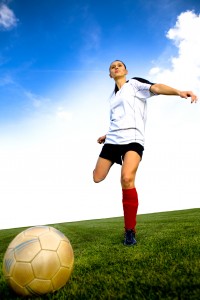
Since the passage of Title IX in 1972, girls’ participation in high school sports has increased more than 900%.1 The speed, power, and intensity displayed by female athletes have dramatically increased over the past decade. The aggressive style of play has led to an increase in musculoskeletal injuries. One of the more common is a sprain or rupture of the anterior cruciate ligament (ACL). This knee injury is the most common cause of permanent disability in female high school basketball players, accounting for up to 91% of season-ending injuries and 94% of injuries requiring surgery.2 In the United States, 20,000 to 80,000 high school female athletes experience ACL injuries each year. There is an incidence rate of 1 out of 100 female high school athletes and 1 in 10 college athletes per season who are injuring their ACLs each year.
What is the ACL?
The knee is essentially a hinged joint that is held together by four ligaments. They include the medial collateral (MCL), lateral collateral (LCL), anterior cruciate (ACL) and posterior cruciate (PCL) ligaments. The ACL runs diagonally in the middle of the knee, preventing the lower leg from sliding out in front of the thigh, as well as providing rotational control to the knee.
Mechanisms of Injury
Sports such as soccer, basketball and volleyball that involve cutting, planting and changing direction, in which the ACL plays a vital role, put athletes, particularly females, at greatest risk of ACL injury. Over two-thirds are non-contact ACL injuries resulting from:
- One-step/stop deceleration
- Cutting movements
- Sudden change in direction
- Landing from a jump with inadequate knee and hip flexion (at or near full extension)
- Lapse of concentration (resulting from unanticipated change in the direction of the play)
Why Female Athletes?
- Women may be more prone to non-contact ACL injuries because they run and cut sharply in a more erect posture than men, and bend their knees less when landing from a jump.
- Why women and girls are more prone to ACL injuries is also likely due to a number of anatomical and hormonal differences between men and women:
- Narrower intercondylar notch and smaller ACL: Not only does the intercondylar notch (the groove in the femur through which the ACL travels) tend to be smaller in women, but so is the ACL itself, leading it more prone to injury.
- Wider pelvis: Women typically have a wider pelvis, which makes the thigh bones angle downward more sharply than in men. The greater the so-called “Q” angle, the more pressure is applied to the inside of the knee, which can cause the ACL to tear.
- More lax ligaments: Women’s ligaments tend to have more “give” (laxity) than men’s. Research has also shown that women’s muscle tissue is more elastic than males. Excessive joint motion combined with increased flexibility may be a significant contributing factor in the higher rate of torn ACLs among women.
- Slower reflex time: Research shows that the muscles stabilizing the knee may take a millisecond longer to respond in women than in men. Scientists suspect that this small difference in contraction time also leads to a higher rate of injury.
- Greater Quadriceps/Hamstring Strength Ratio: It is well-established that female athletes typically have poor hamstring strength,3 which is considered one possible risk factor for ACL ruptures.4 If the hamstring cannot balance the power of the quadriceps (front thigh muscle), the imbalance can cause significant stress to the ACL, leading to injury.
- Changes in estrogen levels: One recent study suggests that changes in estrogen levels during a woman’s menstrual cycle may affect ACL strength, predisposing women to the higher injury rate. A 2007 article in The British Journal of Sports Medicine, however, found “no conclusive evidence directly linking an increase in ACL injury to a predictable time in the menstrual cycle.”
Experts generally believe there are four ways to reduce ACL injuries in female athletes.
- 1. Proper leg muscle strength training and core training;
- 2. Proper neuromuscular (balance and speed) training;
- 3. Proper coaching on jumping and landing and avoiding any straight knee landing;
- 4. Proper footwear and orthotics if necessary (the amount of traction or “grippiness” of athletic shoes needs to fall within an optimal range that minimizes rotational friction to avoid injury yet optimizes transitional friction to allow peak performance in activities such as cutting and stopping).

